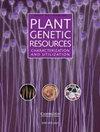大刍草基因渗渗玉米群体遗传资源开发及植物构型相关性状遗传分析
IF 1.2
4区 生物学
Q3 PLANT SCIENCES
Plant Genetic Resources: Characterization and Utilization
Pub Date : 2022-10-26
DOI:10.1017/s1479262122000223
引用次数: 0
摘要
大刍草是玉米的野生祖先,具有提供独特性状的巨大潜力,与自交系和地方品种相比更具差异性。为扩大玉米预驯化等位基因的遗传基础,培育了169个大刍草基因渐渗玉米回交自交系。利用76个SSR标记的表型和基因型数据,对目标性状的数量性状位点(qtl)进行定位。共检测到8个植物构型相关性状的66个qtl,分布在10条不同的染色体上,表型变异范围为2.29% ~ 13.97%。在开花前(DA)记录了最多3个稳定的qtl,其次是在吐丝前(DS)、株高(PH)和结穗前(NBE)记录了2个稳定的qtl。其余3个性状旗叶长(FLL)、旗叶宽(FLW)和穗数(E/P)仅检测到1个稳定QTL。在16个常见QTL中,标记phi328178连锁的QTL同时控制4个性状(DA、DS、FLL、FLW),其次是umc1622连锁的QTL (ASI、FLW、E/P), umc2341连锁的QTL (DA、DS、NBE)和phi075连锁的QTL (ASI、PH、NBE)各控制3个性状。其余12个qtl控制两个字符。不同性状的共定位qtl之间的分子关联也在表型水平上通过显著相关估计得到验证。对8个性状鉴定出53个优良系,并与亲本(大刍草和玉米自交系DI-103)组成12个聚类。因此,独立聚集的株系可以组合起来积累玉米改良所需的性状。本文章由计算机程序翻译,如有差异,请以英文原文为准。
Developing genetic resources and genetic analysis of plant architecture-related traits in teosinte-introgressed maize populations
Teosinte, the wild progenitor of maize, has immense potential for providing unique traits and is more divergent compared to inbred lines and landraces. One hundred and sixty-nine teosinte-introgressed maize backcross inbred lines were developed to widen the genetic base of maize with predomestication alleles. The population was evaluated phenotypically and genotypic data of 76 SSR markers were used to map quantitative trait loci (QTLs) governing the targeted traits. Sixty-six QTLs were detected for eight plant architect-related traits that are spread over 10 different chromosomes with phenotypic variation ranging from 2.29 to 13.97%. Maximum three stable QTLs were recorded for days to anthesis (DA) followed by two for days to silking (DS), plant height (PH) and node bearing first ear (NBE). For rest of three traits namely flag leaf length (FLL), flag leaf width (FLW) and ears per plant (E/P) only one stable QTL was detected. Among the 16 common QTLs, the marker phi328178-linked QTL governed four characters (DA, DS, FLL, FLW) simultaneously, followed by umc1622-linked (ASI, FLW, E/P), umc2341-linked (DA, DS, NBE) and phi075-linked QTLs (ASI, PH, NBE) controlling three traits each. Remaining 12 QTLs controlled two characters. Molecular association between co-localized QTLs for different traits was also validated at the phenotypic level by significant correlation estimates. For eight studied traits, 53 superior lines were identified which along with parents (teosinte and maize inbred DI-103) were grouped into 12 clusters. Therefore, lines clustered independently can be combined to accumulate desirable traits for the improvement of maize.
求助全文
通过发布文献求助,成功后即可免费获取论文全文。
去求助
来源期刊

Plant Genetic Resources: Characterization and Utilization
Agricultural and Biological Sciences-Agronomy and Crop Science
CiteScore
2.80
自引率
0.00%
发文量
29
审稿时长
>12 weeks
期刊介绍:
Plant Genetic Resources is an international journal which provides a forum for describing the application of novel genomic technologies, as well as their integration with established techniques, towards the understanding of the genetic variation captured in both in situ and ex situ collections of crop and non-crop plants; and for the airing of wider issues relevant to plant germplasm conservation and utilisation. We particularly welcome multi-disciplinary approaches that incorporate both a technical and a socio-economic focus. Technical aspects can cover developments in technologies of potential or demonstrated relevance to the analysis of variation and diversity at the phenotypic and genotypic levels.
 求助内容:
求助内容: 应助结果提醒方式:
应助结果提醒方式:


